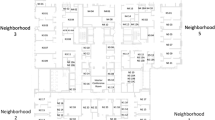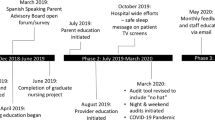Abstract
Objective:
The purpose of the Vermont Oxford Neonatal Quality Improvement Collaborative 2005 was to explore improvements related to the physical environment of the newborn intensive care unit (NICU) in order to optimize the neurodevelopmental outcome of newborns.
Study Design:
Five centers were involved in a focus group examining NICU environmental design and its impact on the neurodevelopmental outcome of the neonate. Using an evidence-based approach, the group identified 16 potentially better care practices. This article describes the implementation approaches for some of these practices. The practice areas include tactile stimulation, providing early exposure to mother's scent, minimizing exposure to noxious odors, developing a system for noise assessment of the NICU acoustic environment, minimizing ambient noise in the infants environment, and preservation of sleep.
Result:
Approaches to implementation were center specific. Optimizing neurodevelopment of the newborn was the desired goal, but this outcome is difficult to measure with a limited number of subjects over a short study period. Many of the changes although intuitively beneficial are difficult to measure. Education of all participants was considered essential to the process of implementation.
Conclusion:
The process of collaborative quality improvement is useful in identifying ways to optimize the physical environment of the NICU to improve the neurodevelopmental outcome of the neonate.
This is a preview of subscription content, access via your institution
Access options
Subscribe to this journal
Receive 12 print issues and online access
$259.00 per year
only $21.58 per issue
Buy this article
- Purchase on Springer Link
- Instant access to full article PDF
Prices may be subject to local taxes which are calculated during checkout




Similar content being viewed by others
References
Horbar JD, Plsek PE, Leahy K . NIC/Q 2000: establishing habits for improvement in neonatal intensive care units. Pediatrics 2003; 111 (4). Available at: www.pediatricds.org/cgi/content/full/111/r/Sel/e397.
Horbar JD, Rogowski J, Plsek PE, Delmore P, Edwards WH, Hocker J et al. Collaborative quality improvement for neonatal intensive care. NIC/Q Project Investigators of the Vermont Oxford Network. Pediatrics 2001; 107: 14–22.
Langley GI, Nolan KM, Nolan TW, Norman CL, Provost LP . The Improvement Guide: A Practical Approach to Enhancing Organizational Performance. Jossey-Bass Publishers: San Francisco, CA, 1996.
Bond C . Positive touch and massage in the neonatal unit: a British approach. Semin Neonatol 2002; 7: 477–486.
Conde-Agudelo A, Diaz-Rossello JL, Belizan JM . Kangaroo mother care to reduce morbidity and mortality in low birthweight infants. Cochrane Database Syst Rev 2003; 4: CD002771 (Available at: http://www.nichd.nih.gov/cochrane/conde-agudelo/conde-agudelo.htm).
Schaal B, Hummel T, Soussignan R . Olfaction in the fetal and premature infant: functional status and clinical implications. Clin Perinatol 2004; 31: 261–285.
Marlier L, Schaal B, Gaugler C, Messer J . Olfaction in premature human newborns: detection and discrimination abilities two months before gestational term. Chem Signals Vertebr 2001; 9: 205–209.
Gray L, Philbin MK . Measuring sound in hospital nurseries. J Perinatol 2000; 19: S100–S104.
Gray L, Philbin K . Effects of the neonatal intensive care unit on auditory attention and distraction. Clin Perinatol 2004; 31: 243–260.
Gadeke R, Doring B, Keller F, Vogel A . Noise levels in a children's hospital and wake-up thresholds in infants. Acta Paediatr Scand 1969; 58: 164–170.
Gray L, Philbin K . Effects of the neonatal intensive are unit on auditory attention and distraction. Clin Perinatol 2004; 31: 243–260.
White R, Martin GI (eds) New standards for newborn intensive care unit (NICU) design. J Perinatol 2006; 26: S1–S30.
Graven S . Early neurosensory visual development of the fetus and newborn. Clin Perinatol 2004; 31: 199–216.
Graven Stanley . Sleep and brain development. Clin Perinatol 2006; 33: 693–706.
Acknowledgements
This report was completed as a part of the NIC/Q 2005 Collaborative to Improve Neonatal Care, which was sponsored by the Vermont Oxford Network. The Group thanks Stanley Graven, MD for clinical expertise, William Liu as the clinical leader and Jim Handyside for expert facilitation. We thank the representatives of the participating centers that contributed their efforts to the preparation of this paper: Benefis Healthcare: Beckett Perkins NNP, Vicki Birkeland RN, BSN, Rob Archer RT, Cheryl Worden RN; Mississippi Baptist Medical Center: Sanjosa Martin RN, Jack Owens MD, Jennifer Richardson NNP; Sunnybrook Health Science Center: Michael Dunn MD, Elizabeth MacMillan-York, Dorothy Dougherty RN; The Children's Hospital of Southwest Florida: Sandra Blackington RNC, MS, Sandra Eanes-McGugan RN, BSN, Marilyn Farley NNP; Wesley Medical Center: Susan Laudert MD, Paula Delmore RNC, MSN.
Author information
Authors and Affiliations
Consortia
Corresponding author
Appendices
NICQ2005: Physical Environment Focus Group Senses and Sensibilities: Appendix 1. NICU Current Practice Survey: NICU Current Practice Assessment: Completed by (circle one):: Staff Nurse or RT/ Management- Administration/ NNP /Physician
Instructions:
Please read each statement carefully. Indicate the extent to which you agree or disagree with the statement by circling the appropriate response (1=Disagree, 3=Agree). These answers should reflect how you feel your Neonatal Intensive Care Unit is at the present time, not how you think it might be in the future or how you might wish it to be.
Response Categories:
You should circle Agree when the statement is a generally accurate description of your unit. You should circle Disagree when the description is a generally inaccurate description of your unit. The response Neither Agree or Disagree should be circled when you believe the statement is neither a particularly accurate nor a particularly inaccurate description of your unit. This may occur if there is wide variation in the accuracy of the statement. If you do not have enough information to answer the question, please circle “Don't Know”
Unless specified otherwise by the question, please answer as follows:
1=Disagree
2=Neither Disagree or Agree
3=Agree
4=Don't know





NICQ2005: Physical Environment Focus Group Senses and Sensibilities: Appendix 2. Implementation worksheet
PBP Neurodevelopmental Bundles and Implementation Strategy Worksheet:



NICQ2005: Physical Environment Focus Group Senses and Sensibilities: Appendix 3. Bedside Audit for Implementation Compliance


Rights and permissions
About this article
Cite this article
Laudert, S., Liu, W., Blackington, S. et al. Implementing potentially better practices to support the neurodevelopment of infants in the NICU. J Perinatol 27 (Suppl 2), S75–S93 (2007). https://doi.org/10.1038/sj.jp.7211843
Published:
Issue Date:
DOI: https://doi.org/10.1038/sj.jp.7211843
Keywords
This article is cited by
-
Sleep state organisation of moderate to late preterm infants in the neonatal unit
Pediatric Research (2023)
-
Survey of preterm neuro-centric care practices in California neonatal intensive care units
Journal of Perinatology (2019)
-
Contextual factors influencing the implementation of the obstetrics hemorrhage initiative in Florida
Journal of Perinatology (2017)
-
The impact of a noise reduction quality improvement project upon sound levels in the open-unit-design neonatal intensive care unit
Journal of Perinatology (2010)



